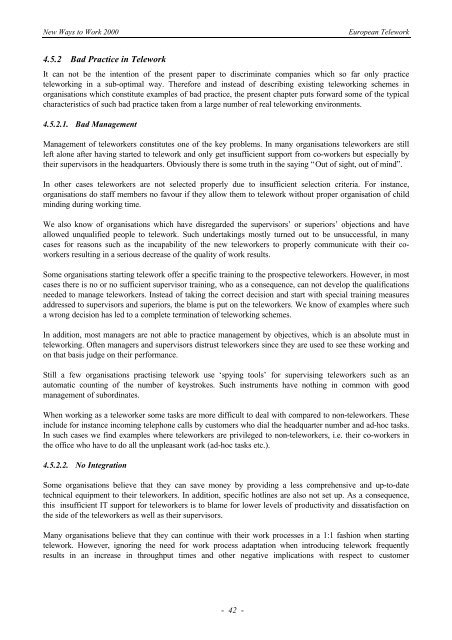eWORK 2000 - European Telework Week
eWORK 2000 - European Telework Week
eWORK 2000 - European Telework Week
- No tags were found...
Create successful ePaper yourself
Turn your PDF publications into a flip-book with our unique Google optimized e-Paper software.
New Ways to Work <strong>2000</strong><strong>European</strong> <strong>Telework</strong>4.5.2 Bad Practice in <strong>Telework</strong>It can not be the intention of the present paper to discriminate companies which so far only practiceteleworking in a sub-optimal way. Therefore and instead of describing existing teleworking schemes inorganisations which constitute examples of bad practice, the present chapter puts forward some of the typicalcharacteristics of such bad practice taken from a large number of real teleworking environments.4.5.2.1. Bad ManagementManagement of teleworkers constitutes one of the key problems. In many organisations teleworkers are stillleft alone after having started to telework and only get insufficient support from co-workers but especially bytheir supervisors in the headquarters. Obviously there is some truth in the saying “Out of sight, out of mind”.In other cases teleworkers are not selected properly due to insufficient selection criteria. For instance,organisations do staff members no favour if they allow them to telework without proper organisation of childminding during working time.We also know of organisations which have disregarded the supervisors’ or superiors’ objections and haveallowed unqualified people to telework. Such undertakings mostly turned out to be unsuccessful, in manycases for reasons such as the incapability of the new teleworkers to properly communicate with their coworkersresulting in a serious decrease of the quality of work results.Some organisations starting telework offer a specific training to the prospective teleworkers. However, in mostcases there is no or no sufficient supervisor training, who as a consequence, can not develop the qualificationsneeded to manage teleworkers. Instead of taking the correct decision and start with special training measuresaddressed to supervisors and superiors, the blame is put on the teleworkers. We know of examples where sucha wrong decision has led to a complete termination of teleworking schemes.In addition, most managers are not able to practice management by objectives, which is an absolute must inteleworking. Often managers and supervisors distrust teleworkers since they are used to see these working andon that basis judge on their performance.Still a few organisations practising telework use ‘spying tools’ for supervising teleworkers such as anautomatic counting of the number of keystrokes. Such instruments have nothing in common with goodmanagement of subordinates.When working as a teleworker some tasks are more difficult to deal with compared to non-teleworkers. Theseinclude for instance incoming telephone calls by customers who dial the headquarter number and ad-hoc tasks.In such cases we find examples where teleworkers are privileged to non-teleworkers, i.e. their co-workers inthe office who have to do all the unpleasant work (ad-hoc tasks etc.).4.5.2.2. No IntegrationSome organisations believe that they can save money by providing a less comprehensive and up-to-datetechnical equipment to their teleworkers. In addition, specific hotlines are also not set up. As a consequence,this insufficient IT support for teleworkers is to blame for lower levels of productivity and dissatisfaction onthe side of the teleworkers as well as their supervisors.Many organisations believe that they can continue with their work processes in a 1:1 fashion when startingtelework. However, ignoring the need for work process adaptation when introducing telework frequentlyresults in an increase in throughput times and other negative implications with respect to customer- 42 -








